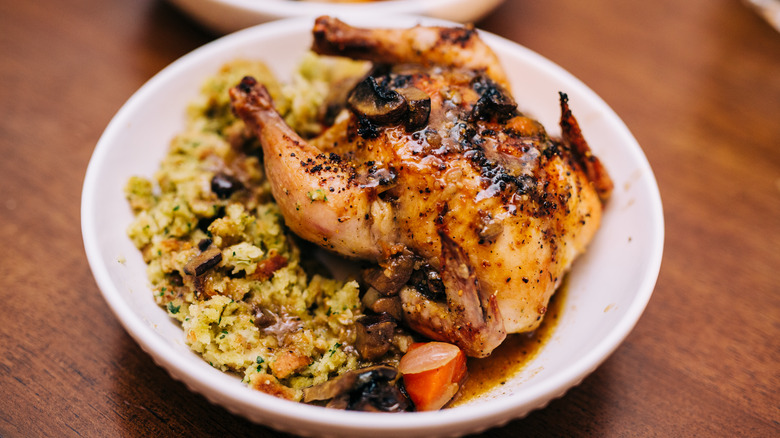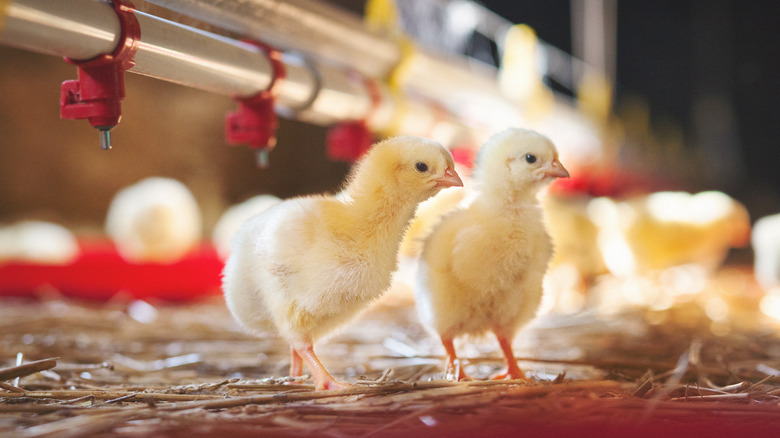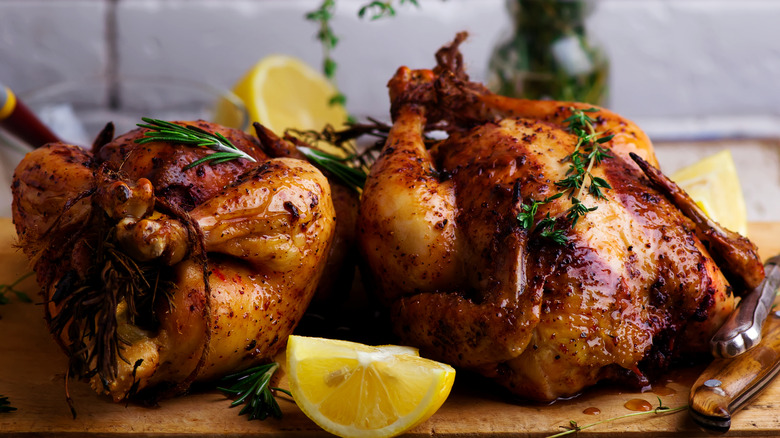What's The Difference Between A Chicken And A Cornish Hen?
The Cornish hen, sometimes called the Cornish game hen, sounds fancy. It seems to stand out on restaurant menus as a delicacy. It's a whole roasted bird just the right size for one person. But in many ways, this is a clever marketing illusion. Despite their special name, the Cornish hen is actually a type of chicken. That's right, when you order an herb-roasted Cornish hen as an entree, you're eating chicken. And it's not always hen, either.
The United States Department of Agriculture doesn't even distinguish Cornish hens from chickens in their reports about the poultry market. For this government agency's purposes, poultry means chickens, turkeys, ducks, and eggs. While the government may not separate Cornish hens from chickens when counting poultry sales, the Cornish hen was originally a specific kind of chicken. There are several variations of this breed, which are usually related to their coloring and their size. And while any chicken can technically be called a Cornish hen these days, there are some qualities that make them stand apart from their fellow chickens.
Cornish hens started out as a special cross-breed
The origin of Cornish hens dates back to the UK in the 1800s. These chickens started out as a cross-breeding experiment and were first known as Indian Game chickens. This breed became recognized in the United States by the American Poultry Association in 1893, and they were later renamed Cornish to reflect their British roots.
In 1948, an enterprising couple named Jacques and Therese Makowsky bought a farm in Connecticut. After losing most of their chickens in a fire, they started developing their own chickens made up of Cornish and Plymouth Rock breeds. This cross-breed became known as Rock Cornish game hens, and these chickens became a huge hit with both restaurants and, later, consumers in markets.
Today, the Cornish hens sold in your supermarket may not be officially Cornish at all — though the Makowskys' birds remain popular. The Food Safety and Inspection Service revised the rules about Cornish hens in 2003 after concluding that most commercially produced Cornish chickens or Rock Cornish chickens weren't purebred (per the Federal Register). There was no easy way to distinguish the authenticity of the chickens, and the term today Cornish has evolved into a classification determined by the chicken's age at harvest and its size.
Cornish hens tastier and more tender
The original Cornish hens were prized for having a substantial amount of tender, white meat for their size. There are still many farms raising this breed today, and even commercially farmed versions are still prized for the quality of their meat. That quality, however, may be a reflection of the age of the mass-market Cornish hens. The USDA currently defines Rock Cornish and Cornish game hens as "an immature chicken younger than five weeks old ... of either sex, with a ready-to-cook carcass weight of two pounds or less."
It's the age and size of the Cornish hen that forms some of the significant differences between it and other chickens you buy at the store. You'll see several other categories of chickens for sale, such as broilers, fryers, and roasters. All of these birds are weeks to months older than Cornish hens when they are prepared for market. This leads to a taste difference between the chickens and the Cornish hens.
Cornish hens are known to have a more delicate flavor than chicken, and they absorb marinades and other seasonings better. Because of their small size, they take a shorter amount of time to cook. So be sure to keep an eye on your roasted Cornish hen when it's in the oven. No one wants to eat a dry bird. You could also try air-frying your Cornish hen, too.


